Forum Replies Created
-
AuthorPosts
-
 Alex PrattParticipant
Alex PrattParticipantHi Mike,
I’ve been getting these on my video meteor cameras, just as you describe – a series of satellite flares from the same location in the sky. To be honest, I haven’t checked their identity, whether Starlink or otherwise (e.g. on Heavens Above). These flares, and the processions of satellite chains, are becoming so common I often delete the video clips, although I have saved a couple for presentation purposes.
Oh the joys of the modern Vermin of the Skies.
Cheers,
Alex
 Alex PrattParticipant
Alex PrattParticipantHi Bill,
Thanks to data from NEMETODE members David Anderson (Dunure), Denis Buczynski (Tarbatness) and William Stewart (Ravensmoor) we can confirm the following: Its ground track
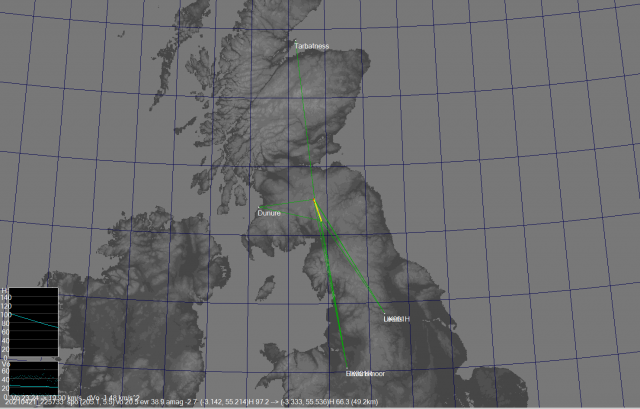
showing it travelled approximately S to N, descending from 97 km altitude to 66 km. It had an absolute mag. of about -3.
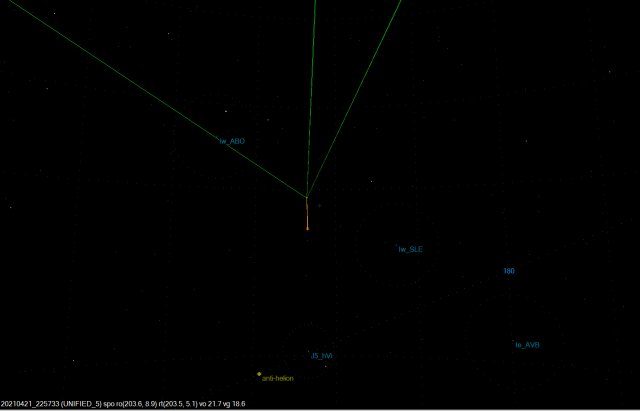
Its radiant was at RA 13h 34m, Dec 5.1, amongst the Virginid / antihelion source. Its Vg was slow, ~18.5 km/s – confirming your assessment!
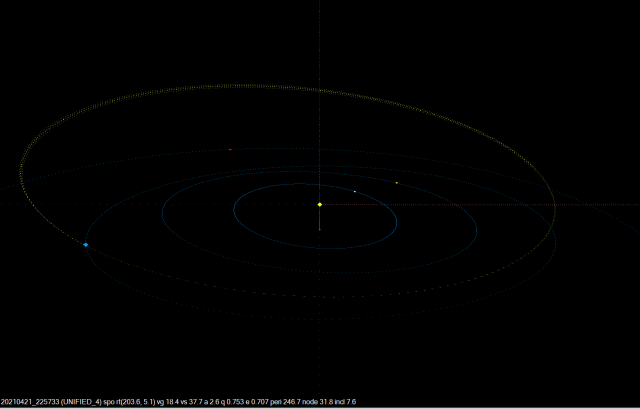
We have a Q3-quality solar system orbit which is very similar to the alpha Virginid (AVB) stream.
Cheers,
Alex.
 Alex PrattParticipant
Alex PrattParticipantHi Denis,
Sally was on my trip to see the 2002 total solar eclipse from Australia’s Nullarbor Plain. She was accompanied by her son. We had wide-ranging chats on various topics, from visual observing to German pronouns…
If I remember correctly, her father wanted her to have a good education, she went to the best schools and she studied the classics. A lady who was so talented and always modest.
Alex.
 Alex PrattParticipant
Alex PrattParticipantHere’s the Sat24 image from 15:00 UT yesterday which shows the cloud cover that masked views of the fireball from southern England
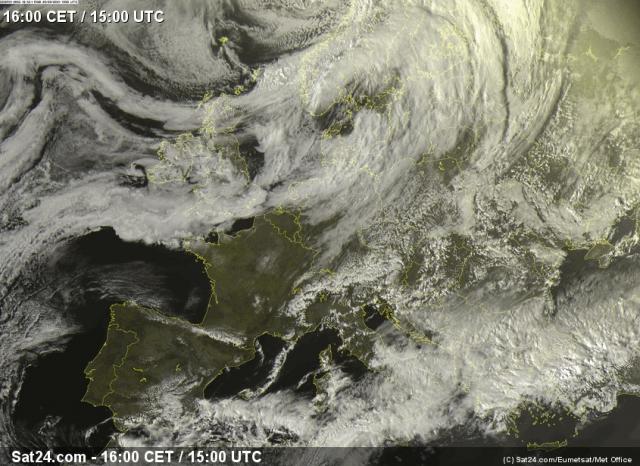
Cheers,
Alex.
 Alex PrattParticipant
Alex PrattParticipantHi Richard,
Here’s its IMO Fireball Event webpage
Fireball event (imo.net)
but almost all observers don’t mention any sound. Is it the same event?NEMETODE members didn’t detect it on radio, but more checks awaited…
Cheers,
Alex. Alex PrattParticipant
Alex PrattParticipantThis is very sad news. I met Ron on numerous occasions and he delighted in explaining the aurora, discussing solar observing and monitoring variable stars, mentioning his well-travelled career as a civil engineer – and his distrust of computers! 🙂
He felt that an engineer should be able to solve problems by working from first principles and their professional training, rather than relying on the integrity of a computer program. This philosophy meant that he didn’t use e-mail, but it was nice to receive letters from him.
Here’s a link to his article on the ‘Jam-Jar Magnetometer’
He liked drawing and always had a sketchbook to hand. I’m proud that I have one of his watercolours of Holyrood Palace and Calton Hill, Edinburgh.
With the passing of Ron and Dr Dave Gavine we have lost, within a year, two of Scotland’s great contributors to British amateur astronomy.
 Alex PrattParticipant
Alex PrattParticipantHi Bill,
Great to see your spectrum of this Ursid. We measured its Vg to be 33.6 km/s (medium speed) and the IAU MDC lists the Ursids’ parent to be comet 8P/Tuttle – why does that remind me of Benny Hill? 🙂
It’s a Jupiter-family comet with a period of 13 years. Well worth reading up about this interesting comet which can make relatively close approaches to Earth.
I’ll check if we got multi-station captures at the times you’ve listed and I’ll reply offline.
Cheers,
Alex.
 Alex PrattParticipant
Alex PrattParticipantHi Bill,
I look forward to seeing your processed spectrum.
David Anderson and I recorded 5 other multi-station Ursids across Scotland last night, so they might be matches for your other spectra. The predictions of enhanced Ursid rates came true in the early hours.
Alex.
 Alex PrattParticipant
Alex PrattParticipantGreat to see Matt Taylor in there… 🙂
 Alex PrattParticipant
Alex PrattParticipantHi Bill,
I caught that meteor on my Leeds_N camera and it confirms it was a Geminid (apparent mag. 0.5 from here).
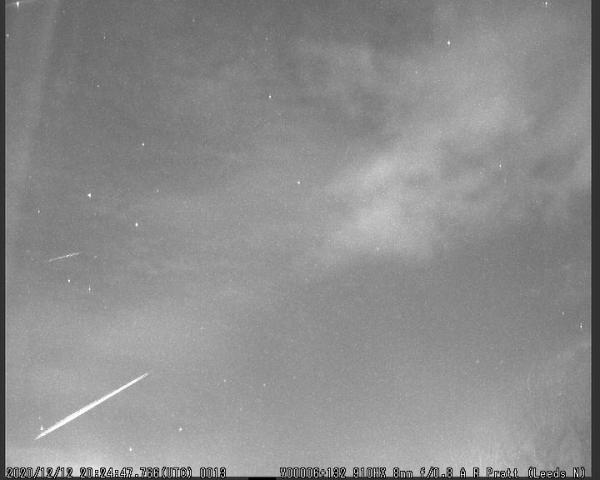
The fainter trail above it was a mag. 2 December alpha Draconid which appeared 2.5 s later.
The weather has cooperated better than expected and my cameras have recorded hundreds of Geminids – keeping me busy.
Clear skies,
Alex.
 Alex PrattParticipant
Alex PrattParticipantHi Dominic,
Many thanks for your work on this significant project and for looking at all the issues raised.
I’m happy to just move forward with new Album entries having correct timestamps and not worry about past entries. They’re for presentation purposes only and the work submitted to Sections will be logged with the correct dates and times.
Cheers,
Alex.
 Alex PrattParticipant
Alex PrattParticipantHi Dominic,
I’ve just added a couple of images taken in September. I always enter my times as UTC, e.g. 2020 Sep 13 23:13:22 but it is listed as Observed 2020 Sep 14 00:13 UTC. That pesky BST !
The ‘Technical details and background story’ window doesn’t have a spell checker. Could this be enabled?
Thanks,
Alex.
 Alex PrattParticipant
Alex PrattParticipantI’ll do some further tests of mags from my Watec 910 with IR/UV blocker. They look to be a reasonable match but I haven’t done a thorough check.
EDR3 is welcomed by many, but the occultation community is awaiting the improved asteroid orbits in the release of Gaia DR3.
Alex.
 Alex PrattParticipant
Alex PrattParticipantThanks Tim, that’s its fancy name now is it? It’s what we’ve been doing for decades. 🙂
Cheers,
Alex.
 Alex PrattParticipant
Alex PrattParticipantHi Alan,
You don’t need accurate time for your photometry, so I hope you can fettle together some circuitry to embed user text into the video stream.
A look at mine and Tim Haymes’ Members’ Pages shows some of the results from video astronomy. Tim wrote a tutorial on Observing asteroidal occultations with digital cameras, which includes many useful links. My notes on video recording lunar occultations should be on the BAA webpages somewhere; here’s an external link to Guide to video astrometry (it’s in need of revision, but most of it is still valid).
Tutorials and webinars are most useful, but when you’ve got a permanent backlog of observations to analyse and report, it’s finding the time…!
Cheers,
Alex.
 Alex PrattParticipant
Alex PrattParticipantHi Alan,
Here is a video frame of its neighbour, NGC 869, taken with the same gear, same exposure
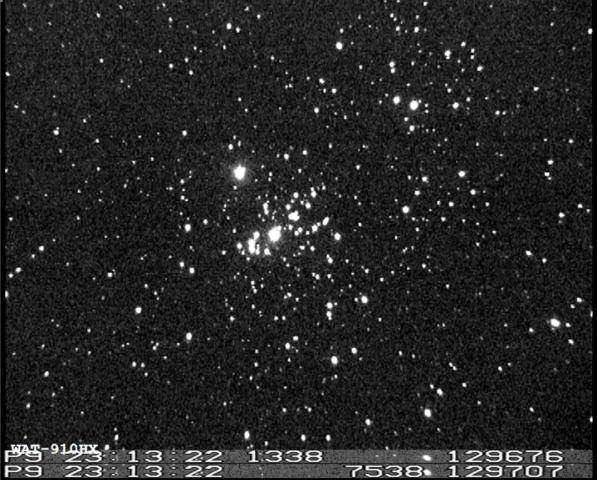
I participate in pro-am projects to record occultation events and for astrometry of NEOs. I need accurate timings, so my timestamps are provided by a 1PPS GPS video time inserter. My current model is the IOTA-VTI Basic. Another popular VTI is GPSBOXSPRITE3. They don’t offer the user an option to add text to the video stream. Some enthusiast have built their own VTIs and added this feature.
You don’t need such timing accuracies for photometry, and with your background you could consider options such as this Arduino Project where you could look at adding text to its timestamps. A Raspberry Pi time server is another option.
Cheers,
Alex.
 Alex PrattParticipant
Alex PrattParticipantDominic – for video meteors I use UFO Capture and Global Meteor Network‘s RMS (Raspberry Pi Meteor Station) software. Both systems employ a video stars-magnitude formula in their camera profile. UFO doesn’t apply any darks or flats, but RMS applies a flat and corrects for vignetting.
Alan – I use OccuRec for video recording asteroidal occultations, video astrometry and (very occasionally) video photometry of variable stars. They are analysed using Tangra. Its video photometry tab (and the link to Hristo’s article) will be of interest to you. As Robin mentioned, photometry is improved by taking more data; CDD photometrists work with S/N ratios of 100 or more, whereas I need accurate timings of transient events, so I’m usually working with single figure S/N ratios. This example compares video astrometry and photometry with traditional CCD results.
Cheers,
Alex.
 Alex PrattParticipant
Alex PrattParticipantAlan,
Here’s an example of a single frame of NGC 884 (Sword Handle, Perseus) from a video taken on 2020 Sep 13 with a Watec 910HX camera on a C11 /f10 with f/3.3 focal reducer. 0.64s integration setting
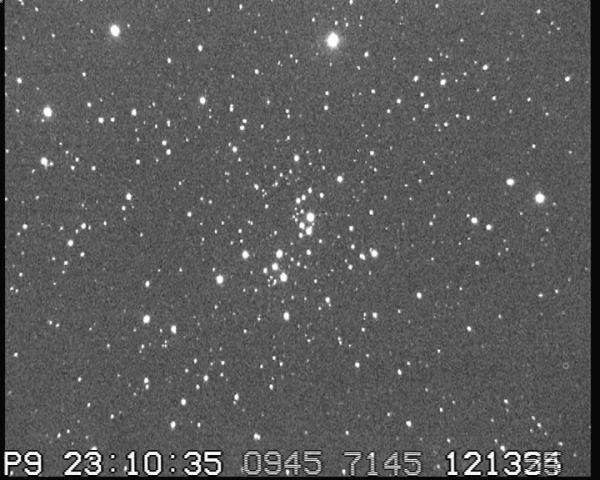
The field is about 30′ across the diagonal and it shows stars to mag. 15.
It’s fun to observe the brighter star clusters in almost real-time, rather than second hand after spending hours taking hundreds of ‘subs’.
Cheers,
Alex.
 Alex PrattParticipant
Alex PrattParticipantHi Alan,
Analogue video cameras, such as the Watec 902H2 Ultimate and the more sensitive Watec 910, give 8-bit output, a brightness range of 256 values. They can measure accuracies to 0.1 mag., such as this light curve of a minimum of the eclipsing binary, RZ Cas
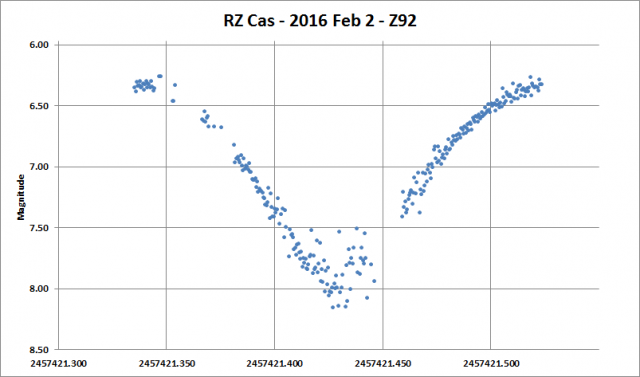
obtained using a Watec 910 camera and an old 50mm f/2 SLR lens. Thin cloud caused the large amount of scatter at minimum. Of course, using a telescope would reach fainter targets.
Video dark frame and flat field recordings can be made and used to calibrate the data.
Members of the Variable Star Section use CCD and CMOS cameras for photometry and produce estimates accurate to 0.01 mag. This is because they are using 12-, 14- or 16-bit sensors, with much larger well depths, supporting a significantly greater range in brightness, giving better accuracy. Exoplanet observers take photometry to an even higher level.
It depends what you want to do. Video photometry is useful for transient events with large magnitude drops and for estimating times of minima of eclipsing binaries, but I suggest looking at the VSS webpages and its Members’ Pages if you wish to do good quality UBVRI photometry.
Cheers,
Alex.
 Alex PrattParticipant
Alex PrattParticipantTim,
Please let us know how you get on. As you well know, we need good pointing accuracy to locate our asteroidal occultation fields. If it does the job it’s a lot quicker than star-drift and much less expensive than buying a bespoke polar gizmo.
I’ll leave you to discuss how many angels can sit in the gap between the reported and the true pole.
Alex.
-
AuthorPosts
